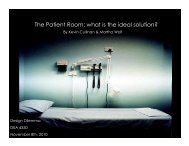The role of physical design and informal communication
The role of physical design and informal communication
The role of physical design and informal communication
Create successful ePaper yourself
Turn your PDF publications into a flip-book with our unique Google optimized e-Paper software.
into the topic <strong>of</strong> nature as a therapeutic feature <strong>of</strong> the built environment. Whall et al.<br />
(1997) found that adding images <strong>of</strong> nature <strong>and</strong> audio recordings <strong>of</strong> chirping birds <strong>and</strong><br />
running water to a shower room reduced stress <strong>and</strong> decreased the occurrence <strong>of</strong><br />
aggressive behavior in patients with late-stage dementia. As a result <strong>of</strong> research on the<br />
pain- <strong>and</strong> stress-reducing impact <strong>of</strong> nature, many hospitals have been <strong>design</strong>ed or<br />
renovated to include water features <strong>and</strong> close-up images <strong>of</strong> birds <strong>and</strong> flowers, such as<br />
the Pebble Project’s Dublin Methodist Hospital in Dublin, Ohio (Ollanketo & Elsas,<br />
2007).<br />
1.2.1.2 Social Support<br />
Another issue gaining recognition from researchers is the concept that the built<br />
environment can foster social support that has the potential to improve medical<br />
outcomes. In the 1990s, medical sociologists explored the intriguing possibility that<br />
social support could have an effect on cure rates <strong>and</strong> recovery rates (Gordy, 1996).<br />
Glass, Matchar, Belyea, <strong>and</strong> Feussner (1993) found that stroke victims with the<br />
greatest amount <strong>of</strong> social support functioned 65% better six months later than stroke<br />
patients who were socially-isolated. This study <strong>and</strong> others that indicated the positive<br />
effect <strong>of</strong> social support on patient well-being (Berkman, Leo-Summers, & Horwitz,<br />
1992; Glass & Maddox, 1992) prompted additional research to investigate ways that<br />
the <strong>physical</strong> healthcare environment facilitates or hinders patients’ access to social<br />
support. For example, many studies have demonstrated that single-bed rooms are<br />
better at accommodating the presence <strong>of</strong> family <strong>and</strong> friends than multi-bed rooms, <strong>and</strong><br />
some evidence proposes that multi-bed rooms actually deter family presence<br />
(Sallstrom, S<strong>and</strong>man, & Norberg, 1987). Evidence such as this in combination with<br />
the Institute <strong>of</strong> Medicine’s patient-centered principles prompted the American College<br />
<strong>of</strong> Critical Care Medicine Task Force to include among its clinical practice guidelines<br />
4







